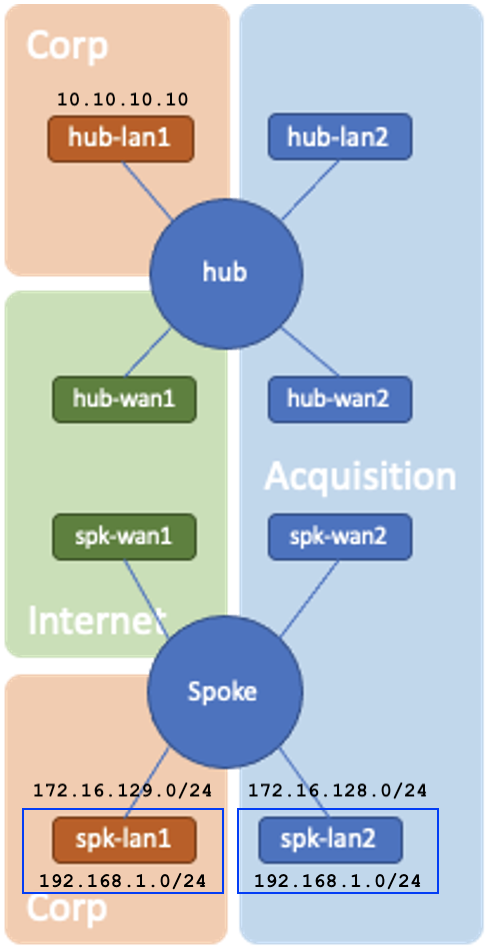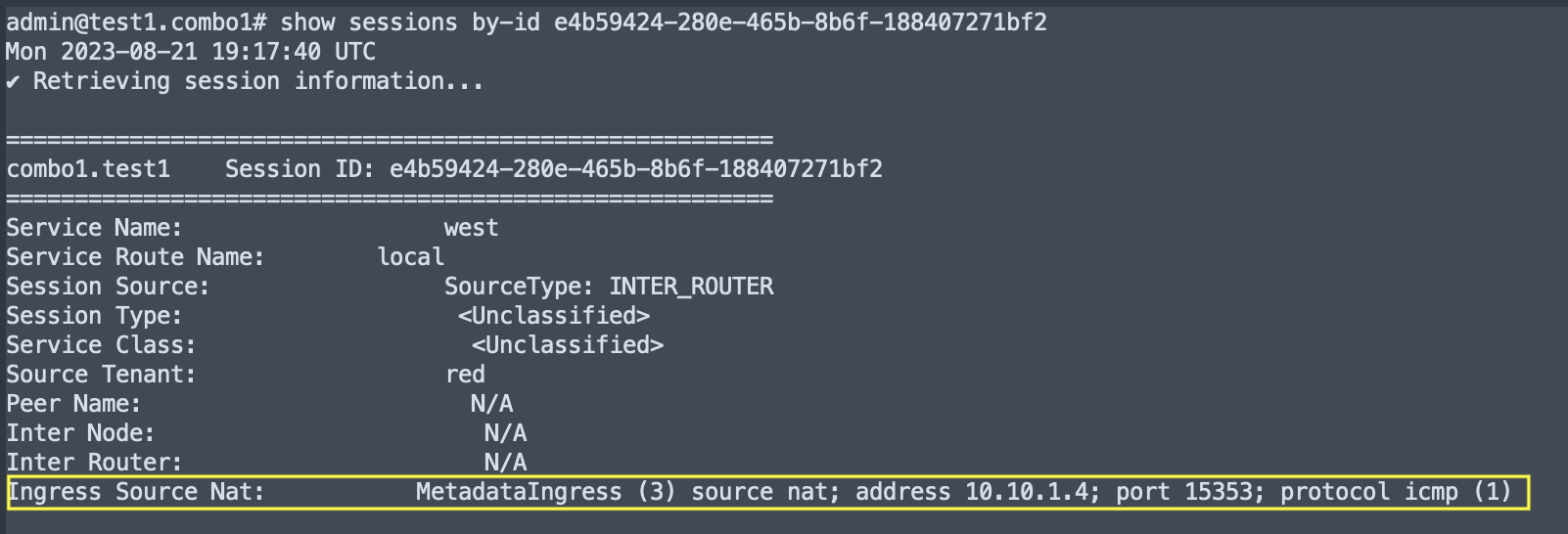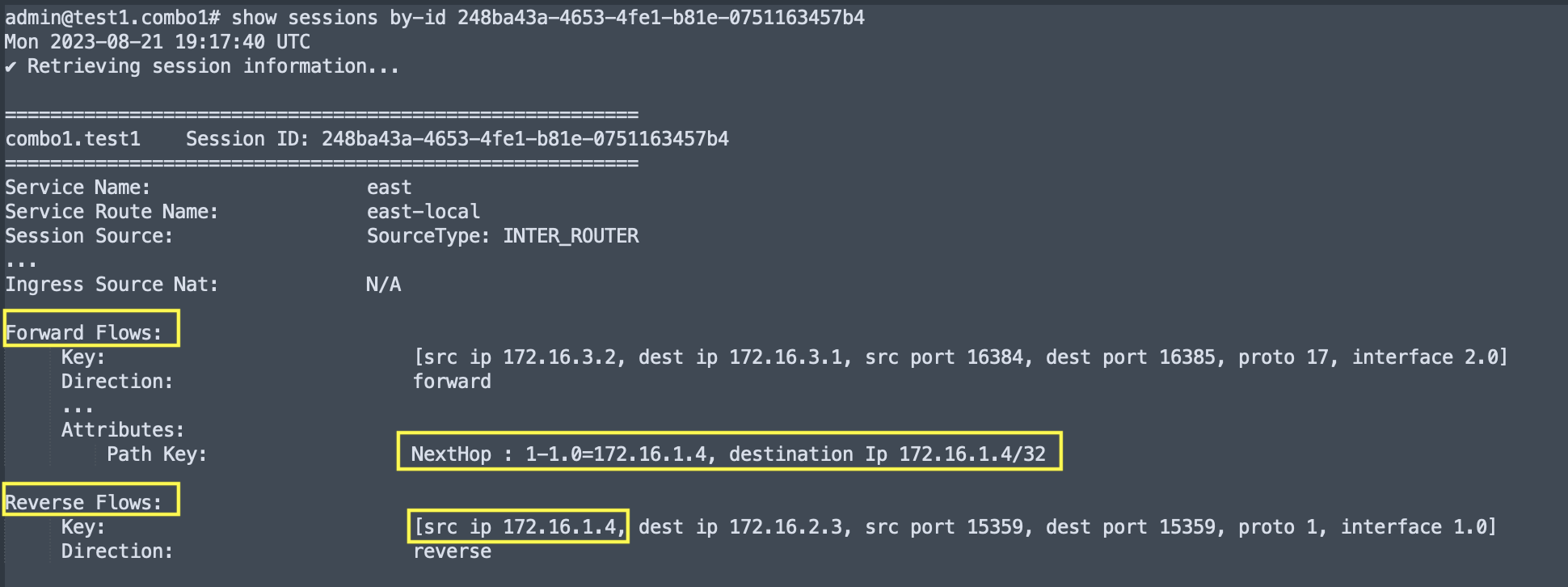Static Bi-directional NAT
SSR supports source NAT pool configurations at interface and service-route level as described in Static NAT Bindings. However, this is not always sufficient to enable simple configuration for static bidirectional NAT between two same-sized subnets.
Static NAT defines a one-to-one mapping from one IP subnet to another IP subnet. The mapping includes source IP address translation in one direction and destination IP address translation in the reverse direction. In cases where IP address overlapping is found, such as when merging networks (for example, a corporate acquisition and merger) this simple configuration change is significantly less work than changing all the local IP addresses. The diagram below illustrates this example.

The spk-lan2 network-interface is not routable (cannot send or receive traffic) in the Corp and Internet networks. The client in spk-lan2 has a local IP within the 192.168.1.0/24 subnet and overlaps with another client from Corp in spk-lan1. This will cause problems for any sessions between hub-lan1 or spk-lan1 to spk-lan2. By configuring bidirectional-nat on spk-lan1 and spk-lan2, the two 192.168.1.0/24 subnets are mapped to 172.16.128.0/24 and 172.16.129.0/24 respectively and differentiate themselves on the hub router.
bidirectional-nat provides value in two ways:
- NAT an unroutable private IP to a routable public IP
- NAT duplicate private IPs (on different routers/networks) to different public IPs to provide differentiation on the receiving end
Example
config
authority
router spoke
node node1-spoke
device-interface spk-lan2
network-interface spk-lan2
bidirectional-nat 192.168.1.0/24
local-ip 192.168.1.0/24
remote-ip 172.16.128.0/24
exit
exit
exit
device-interface spk-lan1
network-interface spk-lan1
bidirectional-nat 192.168.1.0/24
local-ip 192.168.1.0/24
remote-ip 172.16.129.0/24
exit
exit
exit
exit
exit
exit
exit
Non-SVR Traffic
In order for non-SVR traffic (for example, LAN-to-LAN traffic traversing a single SSR) to take advantage of static-NAT addressing, you must disable egress source-nat. This is done in the following locations within the configuration
Service Level
Disable egress source-nat at the service level by setting service > source-nat to disabled as shown below.
authority
service LAN-to-LAN
name LAN-to-LAN
description "LAN-to-LAN non-SVR traffic traversing a single SSR router"
source-nat disabled
scope private
security aes1
address <dest-lan-subnet>
access-policy <src-lan-subnet>
source <src-lan-subnet>
permission allow
exit
exit
exit
Network Interface Level
Disable egress source-nat at the network-interface level by setting network-interface > source-nat to false and not configuring network-interface > egress-source-nat-pool.
authority
router SSR-router
name SSR-router
node SSR-node
name SSR-node
device-interface egress-LAN
name egress-LAN
network-interface egress-LAN
name egress-LAN
source-nat false
egress-source-nat-pool <DON'T CONFIGURE>
exit
exit
exit
exit
exit
Service Route Level
Disable egress source-nat at the service-route level by not configuring service-route > next-hop > source-nat-pool.
authority
router SSR
service-route LAN-to-LAN-route
name LAN-to-LAN-route
service-name LAN-to-LAN
next-hop node egress-LAN
node-name SSR-node
interface egress-LAN
source-nat-pool <DON'T CONFIGURE>
exit
exit
exit
exit
Using the GUI
Set the local and remote IP addresses under Authority > Router > Node > Device Interface > Network Interface.


Show Commands
For details about command output, refer to the show sessions and show sessions by-id commands.
Source NAT
- On the session ingress node, the
show sessions by-idoutput has an Ingress Source NAT field where the source-nat type, NAT’d source address, NAT’d port, and protocol are displayed.

- On the session egress node the
show sessions by-idoutput has an Ingress Source NAT field where the source-nat type, NAT’d source address, NAT’d port, and protocol are displayed.

- The
show sessionsoutput hasNAT IPandNAT Portcolumns where the NAT’d source address and NAT’d source port are displayed.

Destination NAT
- On the session egress node the
show sessions by-idoutput shows the NAT’d destination address in the Forward FlowNextHopand Reverse Flowsrc ipfields.

- The
show sessionsoutput reverse flowsrc ipcolumn also shows the NAT’d destination address.

Version History
| Release | Modification |
|---|---|
| 6.2.0 | Static NAT Feature Introduced |